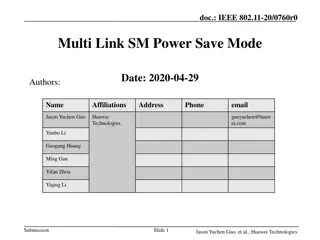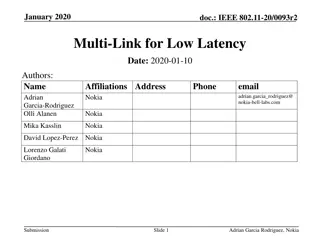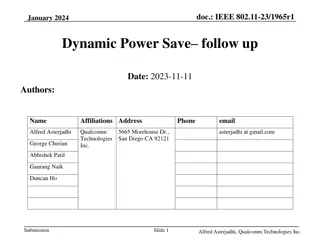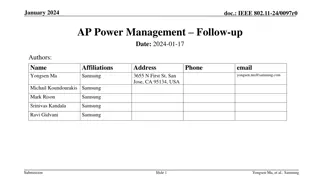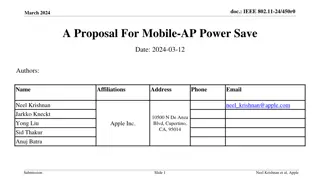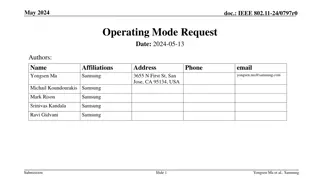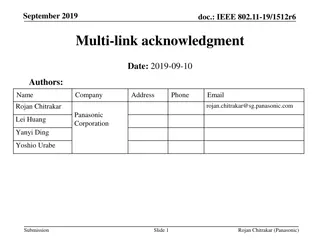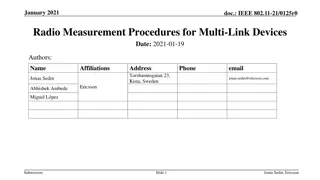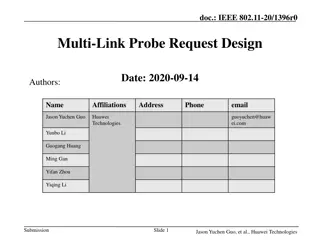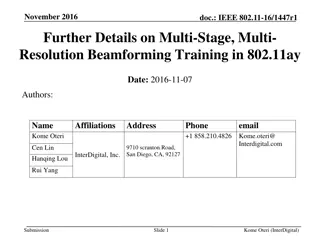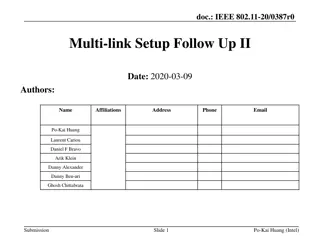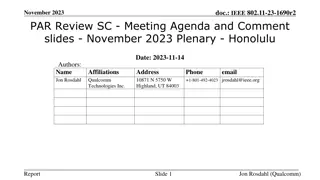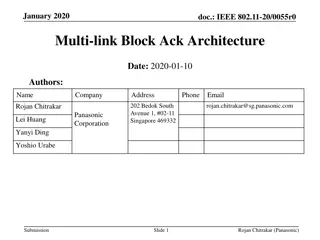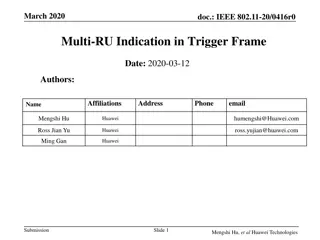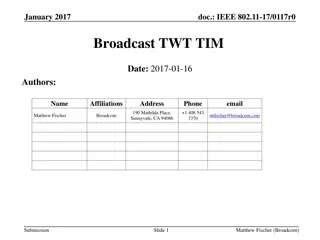Enhancing Power Efficiency in IEEE 802.11 Multi-Link SM Power Save Mode
The document discusses how Multi-Link Operation (MLO) in IEEE 802.11be can improve throughput and reduce latency but may increase power consumption for non-AP devices. It introduces the concept of Multi-Link SM Power Save mode to optimize power usage by activating multiple links only when necessary, building on the dynamic SM power save mode's principles. The implementation enables hardware capabilities in both spatial and frequency domains as needed, balancing power efficiency with network performance.
Download Presentation

Please find below an Image/Link to download the presentation.
The content on the website is provided AS IS for your information and personal use only. It may not be sold, licensed, or shared on other websites without obtaining consent from the author. Download presentation by click this link. If you encounter any issues during the download, it is possible that the publisher has removed the file from their server.
E N D
Presentation Transcript
doc.: IEEE 802.11-23/1922r1 Multi-Link SM Power Save Mode Date: 2023-10-30 Authors: Name Affiliations Address Phone email Jason Yuchen Guo Huawei Technologies guoyuchen@huaw ei.com Yunbo Li Guogang Huang Ming Gan Ross Jian Yu Yue Zhao Maolin Zhang Submission Slide 1 Jason Yuchen Guo, et al., Huawei Technologies
doc.: IEEE 802.11-23/1922r1 Introduction MLO (Multi-Link Operation) is a key feature defined in 802.11be, which brings significant gain in terms of throughput enhancement and latency reduction. On the other hand, since the non-AP MLD needs to operate on at least two links under the MLO, the power consumption of a non-AP MLD also increases comparing with a single link device However, the power consumption is a key factor to determine whether to use a feature or not In this contribution, we discuss how to make use of the Multi-Link feature without bringing significant power consumption Submission Slide 2 Jason Yuchen Guo, et al., Huawei Technologies
doc.: IEEE 802.11-23/1922r1 Recap: Dynamic SM Power Save The dynamic SM power save mode allows a non-AP STA to operate with only one active receive chain for a large portion of time In dynamic SM power save mode, the non-AP STA uses a single RF chain for listening, and switches to the multiple receive chain mode when it receives a frame addressed to it After the frame exchange sequence, the non-AP STA switches back to the single receive chain mode immediately Take away: Enable the hardware capability in the spatial domain only when needed Submission Slide 3 Jason Yuchen Guo, et al., Huawei Technologies
doc.: IEEE 802.11-23/1922r1 Multi-Link SM Power Save After multi-ink setup, the non-AP MLD can use multiple links and multiple RF chains to communicate with the AP Although more links offer more frequency resource, the non-AP MLD may not need so much frequency resource when the traffic load is not so high As an extension to the dynamic SM power save mode, we propose a Multi- Link SM power save (MLSMPS) mode, in which The non-AP MLD uses a single link for listening, and becomes active on multiple links when it receives a frame addressed to it After the frame exchange sequence, the non-AP MLD switches back to the single link mode immediately Key thoughts: Enable the hardware capability in the spatial domain and frequency domain only when needed Note: The concept of the Multi-Link SM Power Save mode has been discussed in TGbe [1] A motion has passed in TGbe to define the Multi-Link SM Power save mode [2] Submission Slide 4 Jason Yuchen Guo, et al., Huawei Technologies
doc.: IEEE 802.11-23/1922r1 Setup In order to use the MLSMPS mode, a non-AP MLD needs to exchange action frames with the AP MLD to setup the MLSMPS mode During the setup procedure, several parameters need to be defined: Non-AP MLD side: MLSM Links: a subset of the enabled links that is used by the non-AP MLD in the MLSM power save mode MLSM Primary Link: the link that the non-AP MLD uses to monitor the initial frame from the AP MLD MLSM Padding Delay: the minimum MAC padding duration of the Padding field of the initial frame requested by the non-AP MLD AP MLD side: MLSM Power Save Transition Timeout: the timeout value for the MLSM Power Save frame exchange in MLSM power save mode Submission Slide 5 Jason Yuchen Guo, et al., Huawei Technologies
doc.: IEEE 802.11-23/1922r1 Initial Frame When the non-AP MLD is operating in the MLSMPS mode, the AP MLD shall begin the frame exchange sequence by transmitting an initial frame to the non-AP MLD on the MLSM primary link The number of spatial streams of the initial frame is limited to 1 The PPDU carrying the initial frame should be in non-HT(duplicate) format The MCS of the PPDU carrying the initial frame is also limited (e.g., MCS 0~3) The padding duration of the initial frame shall be larger than or equal to the value indicated by the non-AP MLD The initial frame needs to carry the following information The links that the AP MLD intends to use to transmit to the non-AP MLD The non-AP MLD shall be able to receive on the links (with the capabilities reported during the ML setup) that are indicated by the AP MLD in the initial frame Submission Slide 6 Jason Yuchen Guo, et al., Huawei Technologies
doc.: IEEE 802.11-23/1922r1 Switch Back After the frame exchange sequence on each of the MLSM links indicated by the AP MLD in the initial frame, the non-AP MLD will Become unavailable on the MLSM links that are not the MLSM primary link Be only able to receive the initial frame from the AP MLD on the MLSM primary link using limited capabilities (e.g., only non-HT(duplicate) PPDU, only one spatial stream, small BW, limited MCS values) If there is no frame exchange sequence happened on any of the MLSM links, the non-AP MLD will become unavailable on that MLSM link after a timeout period. Submission Slide 7 Jason Yuchen Guo, et al., Huawei Technologies
doc.: IEEE 802.11-23/1922r1 Conclusion We propose a MLSMPS mode for the non-AP MLD to use to save power under the MLO framework The non-AP MLD only needs to enable multiple links when there s relative high traffic load. Submission Slide 8 Jason Yuchen Guo, et al., Huawei Technologies
doc.: IEEE 802.11-23/1922r1 Straw Poll Do you agree to define in 11bn a power save mode for a non-AP MLD wherein the non-AP MLD may transition from a lower capability mode to a higher capability mode upon reception of an initial control frame Lower capability mode (e.g., single link, 20 MHz BW, one SS, limited data rates, PPDU format) Higher capability mode (e.g., more links, higher operating BW, NSS or MCSs) Submission Slide 9 Jason Yuchen Guo, et al., Huawei Technologies
doc.: IEEE 802.11-23/1922r1 References [1] 11-20-0760-05-00be-multi-link-sm-power-save-mode [2] 11-20-1935-66-00be-Compendium of straw polls and potential changes to the Specification Framework Document - Part 2 Submission Slide 10 Jason Yuchen Guo, et al., Huawei Technologies


